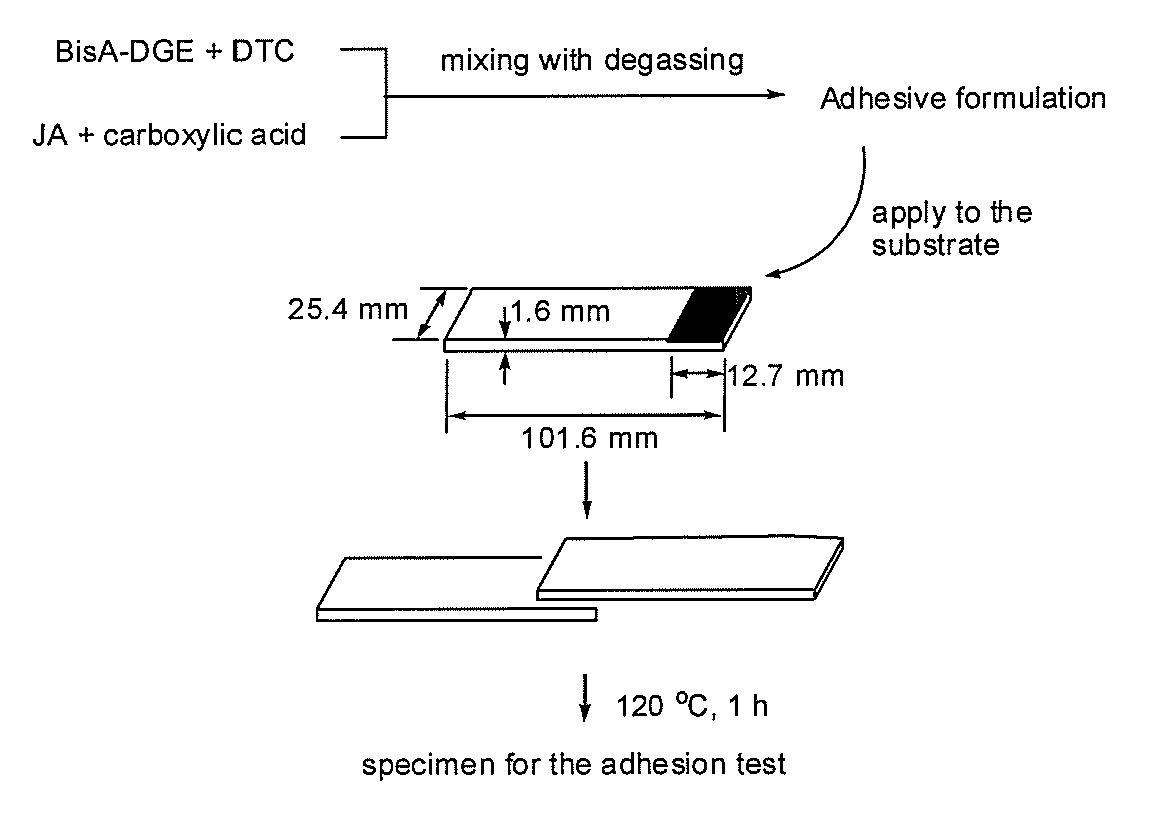Curable compositions having improved adhesion performance
a technology of compositions and adhesion performance, applied in the field of curing epoxy formulations with improved, can solve the problems of lowering the mechanical strength of materials, adhesion failure, corrosion of surfaces,
- Summary
- Abstract
- Description
- Claims
- Application Information
AI Technical Summary
Benefits of technology
Problems solved by technology
Method used
Image
Examples
example 1
Run 5 of Table 1-1
[0100] BisA-DGE (5.10 g, 15.0 mmol) was mixed with BisA-DTC (0.74 g, 1.5 mmol), and stirred at 100° C. until the mixture became homogeneous. JA (3.32 g, 8.3 mmol) was mixed with BA (2.01 g, 16.6 mmol) in bulk, and heated at 80° C., affording a pale yellowish viscous oil, which was added to the mixture of BisA-DGE and BisA-DTC at ambient temperature, and was mixed to obtain a homogeneous mixture, which was then degassed and dried under vacuum. 5 mL of the mixture was weighted in a volume measuring flask at 20° C. to evaluate the density before curing. The density before curing was 1.130. The mixture was poured into a silicone rubber mold, and heated at 120° C. for 1 h to obtain the cured resin as a yellowish solid. The density of the cured resin was measured by an electronic densimeter at 20° C. The density after the curing was 1.160. The volume change value was calculated to be −2.6%.
[0101] In analogy to the above procedure, Examples 2, 3 and 4 (runs 1, 2 and 3 o...
example 5
[0104] The hybrids were prepared by partial modification of the epoxide with CS2 as shown below. The mixtures contain an epoxy-DTC hybrid molecule, BisA-GE-DTC:
[0105] A typical procedure for this modification is:
[0106] To a THF solution (200 mL) of BADGE (51.1 g, 150 mmol, amount of epoxy moiety: 300 mmol) and lithium bromide (0.5 g, 6 mmol), a THF solution (160 mL) of carbon disufide (2.4 mL, 40 mmol) was added dropwise at 0° C. The resulting mixture was stirred at ambient temperature for 21.5 h. By 1H-NMR analysis, the epoxy:DTC content was determined to be 100:10. Further addition of carbon disulfide (0.70 mL, 12 mmol) and stirring the mixture for an additional 7 h resulted in formation of the mixture with an epoxy:DTC content ratio of 100:15. The mixture was concentrated under reduced pressure. The residue was dissolved in ethyl acetate (300 mL), and washed with saturated aqueous solution of sodium chloride (200 mL) three times. The ethyl acetate layer was dried with sodium s...
examples 6 to 9
Runs 1 to 4 in Table 2-1
[0110] The following results show that the addition of organic acid is effective to suppress the reactivity of amine in the formulations containing both an epoxide and DTC, i.e., the formulations do not cure at room temperature but at elevated temperature. In addition, these results show the complete consumption of all the components.
[0111] As an amine, 2-amino-1-methoxypropane (AMP) and as a carboxylic acid benzoic acid (BA) were used. PhODTC was used as a DTC additive. The feed ratio GPE:PhODTC:AMP or AMP+BA mixture was controlled according to the equation: 2*[GPE]0+2*[PhODTC]0=[AMP or AMP+BA]0. All reactions were performed in a sealed glass ampoule in bulk. The conversion was determined by 1H-NMR spectrum in CDCl3. In Table 2-1, all examples are listed.
[0112] As can be seen from Table 2-1, AMP reacts with DTC even at room temperature, while AMP+BA does not. Since AMP+BA does not react with epoxide at room temperature, the mixture consisting of epoxide, ...
PUM
| Property | Measurement | Unit |
|---|---|---|
| shrinkage | aaaaa | aaaaa |
| temperature | aaaaa | aaaaa |
| temperatures | aaaaa | aaaaa |
Abstract
Description
Claims
Application Information
 Login to View More
Login to View More - R&D
- Intellectual Property
- Life Sciences
- Materials
- Tech Scout
- Unparalleled Data Quality
- Higher Quality Content
- 60% Fewer Hallucinations
Browse by: Latest US Patents, China's latest patents, Technical Efficacy Thesaurus, Application Domain, Technology Topic, Popular Technical Reports.
© 2025 PatSnap. All rights reserved.Legal|Privacy policy|Modern Slavery Act Transparency Statement|Sitemap|About US| Contact US: help@patsnap.com



